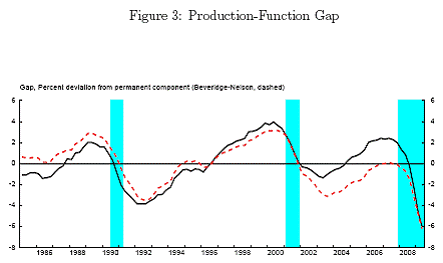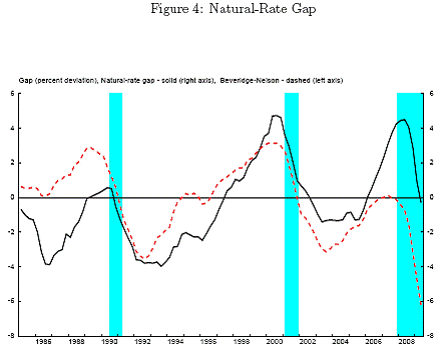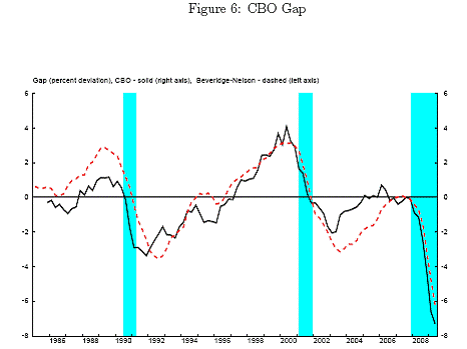Even as inflation continues to fall [0], there are calls to raise interest rates soon in order to quell inflationary pressures. I remember reading similar calls for monetary restraint in Japan in 2000-01, when that country was struggling to escape deflation (I sure had a hard time explaining the fears to my boss, and indeed never came up with a good answer). But rather than dismiss these calls, I think it useful to revisit the different measures of the output gap, to see whether those fears of rampant inflation due to disappearing slack make sense. Fortuitously, Michael Kiley has just circulated a new paper reviewing the various concepts of the output gap (see also these previous posts: [1] [2] [3]).
What is the output gap? There are many definitions in the economics literature, all of which have a long history. I discuss three alternatives: the deviation of output from its long-run stochastic trend (i.e., the “Beveridge-Nelson cycle”);
the deviation of output from the level consistent with current technologies and
normal utilization of capital and labor input (i.e., the “production-function
approach”); and the deviation of output from “flexible-price” output (i.e., its
“natural rate”). Estimates of each concept are presented from a dynamic-
stochastic-general-equilibrium (DSGE) model of the U.S. economy used at the
Federal Reserve Board. Four points are emphasized: The DSGE model’s es
timate of the Beveridge-Nelson gap is very similar to gaps from policy institutions, but the DSGE model’s estimate of potential growth has a higher
variance and substantially different covariance with GDP growth; the natural
rate concept depends strongly on model assumptions and is not designed to
guide nominal interest rate movements in “Taylor” rules in the same way as
the other measures; the natural rate and production function trends converge to
the Beveridge-Nelson trend; and the DSGE model’s estimate of the Beveridge-
Nelson gap is as closely related to unemployment fluctuations as those from
policy institutions and has more predictive ability for inflation.
The output gaps are shown in three graphs from the paper.

Figure 3 from Kiley (2010).

Figure 4 from Kiley (2010).

Figure 6 from Kiley (2010).
Based upon his analysis, Kiley makes the following four conclusions:
- The EDO model’s estimate of the output gap (according to either a Beveridge-Nelson or production-function approach) is very similar to gaps from the Congressional
Budget Office or the Federal Reserve’s large-scale macro-econometric model (FRB/US) model, but the DSGE model’s estimate of potential growth is considerably more variable; the latter result stems from the significant degree of fluctuation in aggregate technology estimated by the DSGE model, a result consistent with the significant role such fluctuations play in model’s descended from those of the real-business-cycle tradition (from Kydland and Prescott (1982)).- The flexible-price/natural-rate gaps are highly dependent on modeling assumptions,
and their use in policy applications or forecasting requires a deep understanding
of a specific model’s structure. (This result is closely related to the
critique of DSGE models of Chari, Kehoe, and McGrattan (2009), who highlight
the sensitivity of policy applications of such models to controversial modeling
assumptions). In particular, a natural-rate gap does not provide the same type
of guidance to a “Taylor” rule for nominal interest rates as other concepts of
gaps; indeed, the signals from the Beveridge-Nelson gap provide a better sense
of movements in the “natural rate of interest” than do the signals from the
natural rate of output gap.- “Equilibrium” or trend expected growth is highly variable in the flex-price/naturalrate
case, implying that a focus on the current level of such gaps can be misleading
in a policy discussion. In contrast, expected trend growth for the Beveridge-
Nelson concept is exogenous and constant; moreover, all other notions of “trend”
converge to the Beveridge-Nelson trend.- The DSGE model’s estimate of the Beveridge-Nelson gap is as closely related to
unemployment fluctuations as those from policy institutions (e.g., obeys Okun’s
law) and has more predictive ability for inflation (e.g., has a tighter reduced form
Phillips curve relationship).
For me, one important observation is that the output gap for both the production function based approach from EDO and the CBO estimate are of similar magnitude; 6 ppts and 7.5 ppts of GDP at 09Q2. The natural rate output gap is quite different, and this highlights the fact that this gap embodies a very different concept (discussed at length in the paper). I stress this, exactly because I know somebody is going to take some output gap measure and mis-interpret the implications of that gap — especially as concerns of inflation rise.
i would say: mind the recovery. if that recovery falters when rates go up 0-0.25% to 1-2%, then what kind of recovery is that, japanese style lost decade?
Part of the problem this analysis faces among non-specialists is that the whole notion of an output gap has been pooh-poohed (apologies to Edward Bear) by a number of high-profile economists and policy makers. The typical objection is that the output gap cannot be measured directly, and that estimates of the output gap vary considerably, making the output gap problematic as a guide to monetary policy. The obvious conclusion to draw is that when estimates are all or mostly of a very large gap, then you have the necessary information, but that when when some estimates get nearer to tightening territory, the problem with estimates becomes serious. That is not, however, how I hear the problem stated by non-specialists. They have drawn the conclusion that “the output gap doesn’t work”. This fits right in with Krugman’s notion of “conventional thinking”.
Menzie:
Something that I wrestle with is the question of whether all output gaps (assuming they are measured correctly) are the same. Let me explain. Let’s say there is a negative output gap. If it were created by a negative AD shock then it then the notion of an output gap as it is normally used makes senses (i.e. policy should aim to close the gap). What if, however, the negative output gap were created by a positive AS shock, say a surge in the productivity growth rate. It is far from clear to me that this creates the same problem as one from a negative AD shock.
Any thoughts? Thanks in advance.
Mr. Chinn,
I’m sure that there are some out there wanting to see rates rise in order to give some cushion against inflation, however, I do not suspect that this is the case, at least not in intermediate term rates (long terms rates are anyone’s guess what the world will look like in 20-30 yrs time). The call for higher interest rates will not be coming from inflation fears but credit risk fears, that is, we could have a deflationary situation where interest rates are rising due to credit risk–one might be tempted to look to the 1930’s as a prime example, but I do not suspect this to be comparable in that the United States, primarily, was not so over extended then as it is now. Further, yields may have to rise to compete against other investment opportunities, and there are a lot more choices for investors than ever before (primarily into commodities and other markets).
Again, inflationary concerns are not the only considerations when considering where interest rates should be, but also (1) credit risks, and (2) competing investments (opportunity costs). I’m sure some may want to argue that the US government is not a credit risk, but I think it could plausibly be argued that the dissolution of the Bretton Woods Agreement was an indirect default by the US gov.
David,
what if it was both? And more?
I think the inflation fears come from fear of a sudden change in expectations about future inflation (brought about, for example, by doubts that the Treasury will be able to make debt payments). Under such circumstances, it seems very possible to me that even a small amount of friction in production could allow a sudden change in expectations to give rise to very real dangers of inflation, even with a fairly high level of unemployment. Dramatic dollar depreciation, which would accompany such a change in expectations, could cause prices of raw materials and other imports to jump. (Since we make little of our manufactured consumption these days, it would take time to gear up import competing production, and also to increase exports.) The process may be self-perpetuating for a short but painful period, not through the usual cycle of price increases spurring labor wage demands, but by the spiral of expectations of Treasury default causing an increase in U.S. borrowing costs and exacerbating the dollar decline.
We have had “stagflation” before.
David & Cedric, what if a positive AS shock from positive productivity growth and/or cheap labor is not handled correctly? That is interest rates are allowed to fall and debt levels rise without excess price inflation, meaning some “entity” is experiencing negative real “earnings” growth.
Next, debt defaults happen because of the effects of the positive AS shock on the balance sheets of the “entity” experiencing negative real “earnings” growth, and those debt defaults lead to what looks like a negative AD shock.
Should output gaps be “filled” with currency or debt?
What if there is a domestic output gap because of a trade deficit?
Reading the models and their assumptions does not provide more comfort from the output.
These models are attempting to integrate many variables from Cobb Douglas production function, to the assumption of a real utility curve in consumption, save the risks (national incomes,current accounts,private incomes,savings).
In essence the interest rates are having a rigid reading of the evolving economies.
So our choices are either raise or lower interest rates – NOT! Interest rates are like prices. Whether the government raises or lowers them it distorte the supply/demand ratio. So this whole line of reasoning is foolish. If interest rates are not the same as the natural rate of interest they create economic distortion and decline.
I agree with your first sentence that inflationary pressure is currently non-existant. People who are currently worried about inflation see high government spending and loose money supply, but fail to realize that the output gap calls for these fiscal and monetary policy actions.
Inflatioin has a lot of inertia, so it can be predicted in the short term. However, can unexpected inflation be predicted? For example, what if the FED becomes more politicized or someone like Ralph Nader or Ron Paul gets elected?
David Beckworth: That’s an interesting question. From the perspective of the model, and using an objective function expressed in terms of the output gap w/quadratic loss, I don’t think that one should care how the gap arises.
On the other hand declining marginal utility of consumption might suggest that one cares more about deficient AD as opposed to higher AS. That’s an informal thought…
Menzie,
Athanasios Orphanides has long argued that measuring output gap in real time is close to impossible and in fact, the great inflation in the 70’s can mostly be attributed to the real time mis-perception of output gap. Here is the link to one of his papers, I find Figure 5 (page 48) fascinating:
http://www.federalreserve.gov/pubs/feds/2003/200336/200336pap.pdf